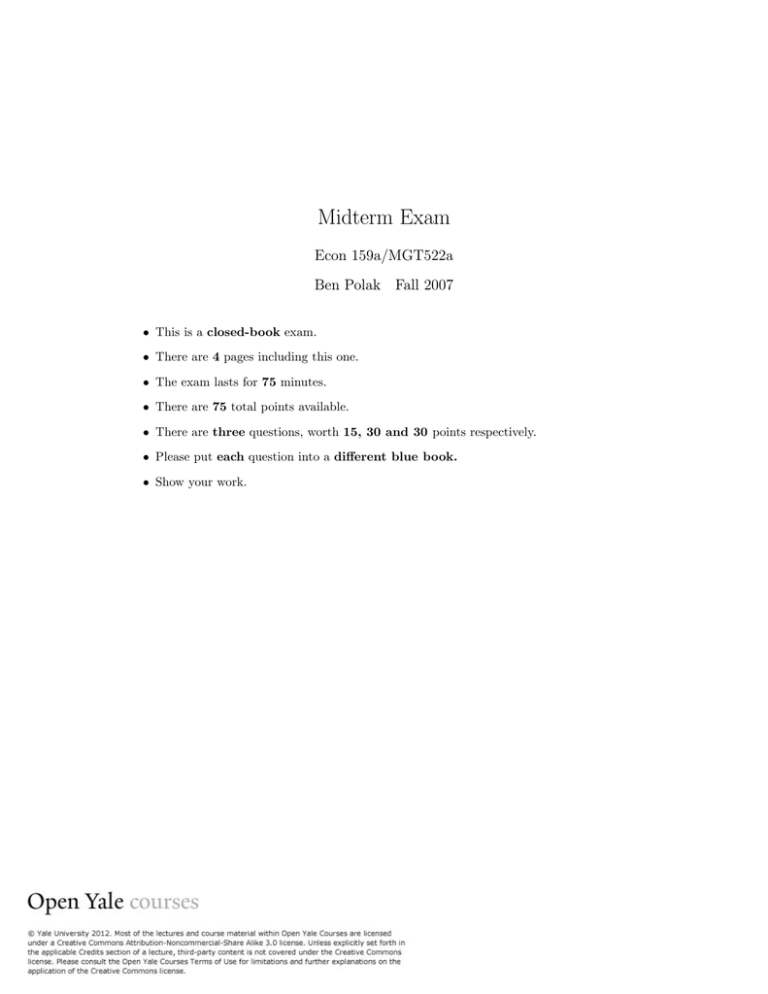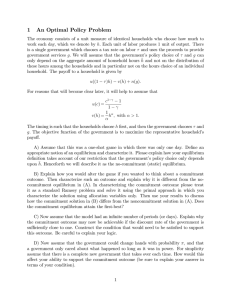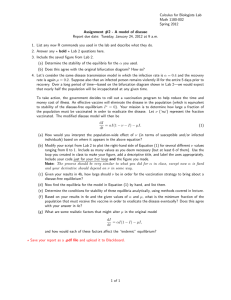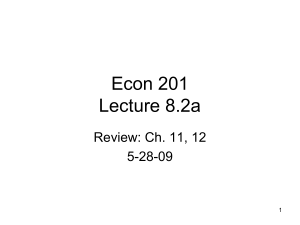Midterm Exam (from 2007)
advertisement

Midterm Exam
Econ 159a/MGT522a
Ben Polak Fall 2007
This is a closed-book exam.
There are 4 pages including this one.
The exam lasts for 75 minutes.
There are 75 total points available.
There are three questions, worth 15, 30 and 30 points respectively.
Please put each question into a di erent blue book.
Show your work.
Question 1. [15 total points: use blue book 1]. Short-Answer Questions.
State whether each of the following claims is true or false (or can not be determined). For each,
explain your answer in (at most) one short paragraph. Each part is worth 5 points, of which
4 points are for the explanation. Explaining an example or a counter-example is su cient.
Absent this, a nice concise intuition is su cient: you do not need to provide a formal proof.
Points will be deducted for incorrect explanations.
(a) [5 points] \A strictly dominated strategy can never be a best response."
(b) [5 points] \In the candidate-voter model, if two people are standing, one to the left of
center and one to the right of center, and neither of them is `too extreme', then it is an
equilibrium."
(c) [5 points] \If (^
s; s^) is a Nash equilibrium of a symmetric, two-player game then s^ is
evolutionarily stable."
2
Question 2. [30 total points] \Party Games". Roger has invited Caleb to his party. Roger
must choose whether or not to hire a clown. Simultaneously, Caleb must decide whether or
not to go the party. Caleb likes Roger but he hates clowns { he even hates other people seeing
clowns! Caleb's payo from going to the party is 4 if there is no clown, but 0 if there is a clown
there. Caleb's payo from not going to the party is 3 if there is no clown at the party, but 1 if
there is a clown at the party. Roger likes clowns { he especially likes Caleb's reaction to them
| but does not like paying for them. Roger's payo if Caleb comes to the party is 4 if there is
no clown, but 8 x if there is a clown (x is the cost of a clown). Roger's payo if Caleb does
not come to the party is 2 if there is no clown, but 3 x if there is a clown there.
(a) [6 points] Write down the payo matrix of this game.
(b) [6 points] Suppose x = 0. Identify any dominated strategies. Explain. Find the Nash
equilibrium. What are the equilibrium payo s?
(c) [6 points] Suppose x = 2. Identify any dominated strategies. Explain. Find the Nash
equilibrium. What are the equilibrium payo s?
(d) [6 points] Suppose x = 3. Identify any dominated strategies. Explain. Find the Nash
equilibrium. What are the equilibrium payo s?
(e) [6 points] Suppose x = 5. Identify any dominated strategies. Explain. Find the Nash
equilibrium. What are the equilibrium payo s?
3
Question 3. [30 total points] \Road Trip". Six Yale students are going on a foreign trip
on which they will live close together. Where they are going, there is a disease which spreads
easily among people who live close together. The value of the trip to a student who does not
get the disease is 6. The value of the trip to a student who gets the disease is 0.
There is a vaccination against the disease. The vaccination costs di erent amounts for
di erent students (perhaps they have di erent health plans). Let's call the students 1; 2; 3; 4; 5
and 6 respectively. The vaccination costs 1 for student 1; it costs 2 for student 2; etc....
If a student gets vaccinated, she will not get the disease. But, if she is not vaccinated then
her probability of getting the disease depends on the total number in the group who are not
vaccinated. If she is the only person not to get vaccinated then the probability that she gets the
disease is 1=6. If there is one other person who is not vaccinated (i.e., two in all including her)
then the probability that she gets the disease is 2=6. If there are two other people who are not
vaccinated (i.e., three including her) then the probability that she gets the disease is 3=6, etc..
[For example, suppose only students 2 and 4 get vaccinated. Then 2's expected payoff is 6 [2] where the [2] is the cost of
4's expected payoff in this case is 6 [4]. Student 5's expected payoff in this case (recall she did not get
4
4
2
6
+
vaccinated) is
6
6 0 = 2 where the fraction 6 is the probability that she gets the disease.]
the vaccination. Student
To make this into a game, suppose that each student aims to maximize her expected payo .
The students decide, individually and simultaneously, whether or not to get a vaccination.
(a) [8 points] Explain concisely whether or not it is a Nash equilibrium for students 1,2,3
and 4 to get vaccinated and students 5 and 6 not to get vaccinated.
(b) [8 points] Explain concisely whether or not it is a Nash equilibrium for students 1,2
and 3 to get vaccinated and students 4,5, and 6 not to get vaccinated.
(c) [6 points] Which players in this game have strictly or weakly dominated strategies?
Explain your answers carefully including whether any domination is strict or weak.
(d) [4 points] If we delete all strictly and weakly dominated strategies from all players, which
players in the game now have (iteratively) strictly or weakly dominated strategies? Explain
carefully.
(e) [4 points] [Harder] Find all the (possibly mixed) NE in this game. Explain.
4




